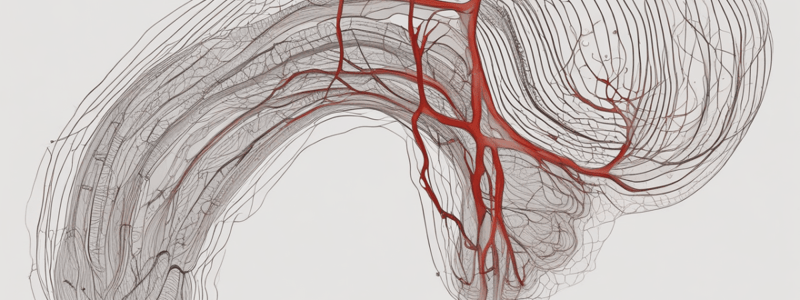Podcast
Questions and Answers
What is the primary reason why the brain has a high capillary density?
What is the primary reason why the brain has a high capillary density?
- To meet the brain's high oxygen demand (correct)
- To increase the basal flow rate
- To increase the distance for oxygen diffusion
- To reduce blood flow to the brain
What is the effect of an increase in blood flow on vessel diameter in the brain?
What is the effect of an increase in blood flow on vessel diameter in the brain?
- Variable response
- No change in vessel diameter
- Vasoconstriction (correct)
- Vasodilation
What is the primary stimulus for metabolic autoregulation in the brain?
What is the primary stimulus for metabolic autoregulation in the brain?
- Change in pCO2 levels (correct)
- Change in oxygen levels
- Change in temperature
- Change in blood pressure
What is the effect of Cushing's reflex on heart rate?
What is the effect of Cushing's reflex on heart rate?
What is the primary function of skeletal muscle circulation during exercise?
What is the primary function of skeletal muscle circulation during exercise?
What is the effect of a pathological increase in intracranial pressure on blood flow to the brain stem?
What is the effect of a pathological increase in intracranial pressure on blood flow to the brain stem?
What is the term for the triad of symptoms that occurs when Cushing's reflex fails?
What is the term for the triad of symptoms that occurs when Cushing's reflex fails?
What is the primary mechanism by which the Circle of Willis maintains a constant blood supply to the brain?
What is the primary mechanism by which the Circle of Willis maintains a constant blood supply to the brain?
What is the primary reason why the brain is very intolerant to reduced blood supply?
What is the primary reason why the brain is very intolerant to reduced blood supply?
Which of the following adaptations helps maintain a constant blood supply to the brain in case one side fails?
Which of the following adaptations helps maintain a constant blood supply to the brain in case one side fails?
What is the effect of hypocapnia on cerebral blood flow?
What is the effect of hypocapnia on cerebral blood flow?
What is the primary function of skeletal muscle circulation during rest?
What is the primary function of skeletal muscle circulation during rest?
Which of the following is NOT a feature of cerebral circulation?
Which of the following is NOT a feature of cerebral circulation?
What is the effect of increased intracranial pressure on sympathetic activity?
What is the effect of increased intracranial pressure on sympathetic activity?
Which of the following is a feature of Cushing's reflex?
Which of the following is a feature of Cushing's reflex?
Flashcards are hidden until you start studying
Study Notes
Cerebral Circulation
- Brain has a high oxygen demand and is very intolerant to reduced blood supply.
- Interruptions in blood supply can lead to unconsciousness within 5 seconds and irreversible damage after 4 minutes.
- Adaptations to ensure constant blood flow include:
- High capillary density in the brain.
- Short diffusion distance of approximately 10 um.
- High basal flow rate.
- High oxygen extraction from the blood.
Maintenance of Constant Blood Flow
- Structural adaptations:
- Circle of Willis, which provides anastomoses between basilar and internal carotid arteries, ensuring a constant blood supply to the brain.
- Functional adaptations:
- Myogenic autoregulation:
- Increase in blood pressure leads to constriction of blood vessels.
- Decrease in blood pressure leads to vasodilation.
- Metabolic autoregulation:
- Increase in pCO2 (hypercapnia) leads to vasodilation.
- Decrease in pCO2 (hypocapnia) leads to vasoconstriction.
- Myogenic autoregulation:
Cushing's Reflex
- Pathological increase in intracranial pressure (ICP) compresses the brain, leading to:
- Impaired blood flow to the brain stem.
- Increase in sympathetic activity.
- Increase in blood pressure.
- Increase in blood flow.
- If this fails, Cushing's triad occurs, characterized by:
- Bradycardia.
- Irregular respiration.
- Systolic hypertension.
Skeletal Muscle Circulation
- Functions:
- Meeting metabolic needs during exercise.
- Many capillaries are closed off from the rest of the circulation due to the contraction of pre-capillary sphincters.
Cerebral Circulation
- Brain has a high oxygen demand and is very intolerant to reduced blood supply.
- Interruptions in blood supply can lead to unconsciousness within 5 seconds and irreversible damage after 4 minutes.
- Adaptations to ensure constant blood flow include:
- High capillary density in the brain.
- Short diffusion distance of approximately 10 um.
- High basal flow rate.
- High oxygen extraction from the blood.
Maintenance of Constant Blood Flow
- Structural adaptations:
- Circle of Willis, which provides anastomoses between basilar and internal carotid arteries, ensuring a constant blood supply to the brain.
- Functional adaptations:
- Myogenic autoregulation:
- Increase in blood pressure leads to constriction of blood vessels.
- Decrease in blood pressure leads to vasodilation.
- Metabolic autoregulation:
- Increase in pCO2 (hypercapnia) leads to vasodilation.
- Decrease in pCO2 (hypocapnia) leads to vasoconstriction.
- Myogenic autoregulation:
Cushing's Reflex
- Pathological increase in intracranial pressure (ICP) compresses the brain, leading to:
- Impaired blood flow to the brain stem.
- Increase in sympathetic activity.
- Increase in blood pressure.
- Increase in blood flow.
- If this fails, Cushing's triad occurs, characterized by:
- Bradycardia.
- Irregular respiration.
- Systolic hypertension.
Skeletal Muscle Circulation
- Functions:
- Meeting metabolic needs during exercise.
- Many capillaries are closed off from the rest of the circulation due to the contraction of pre-capillary sphincters.
Studying That Suits You
Use AI to generate personalized quizzes and flashcards to suit your learning preferences.




